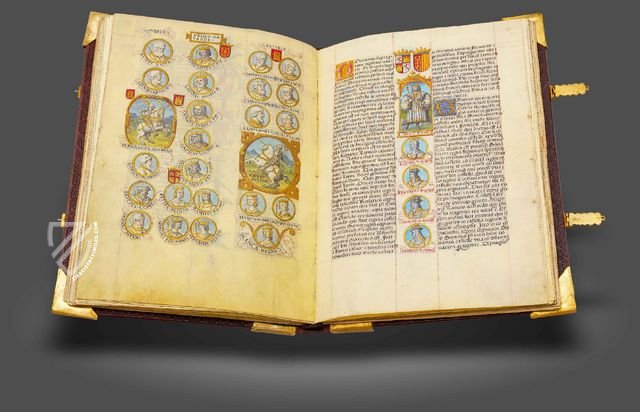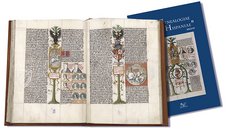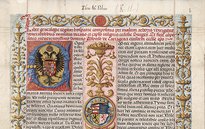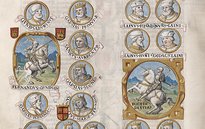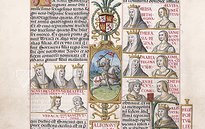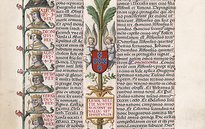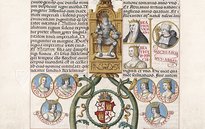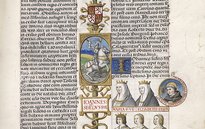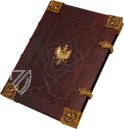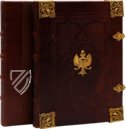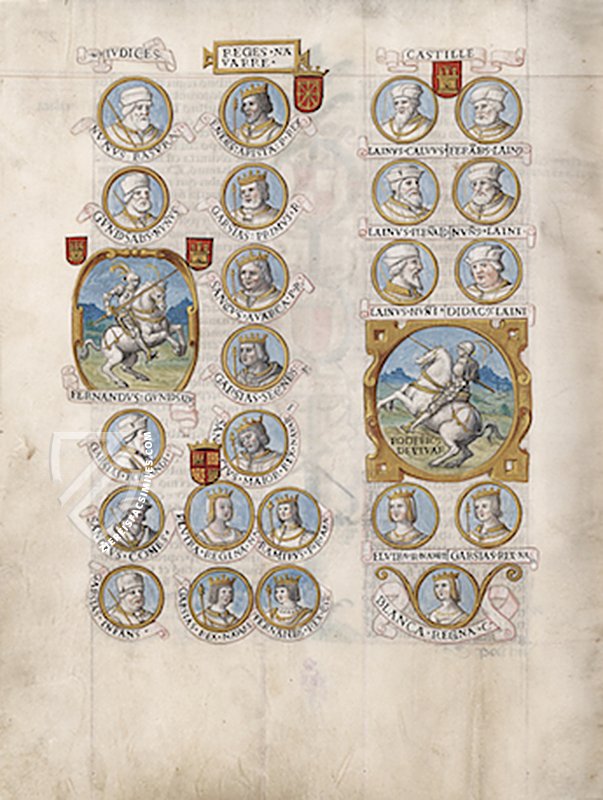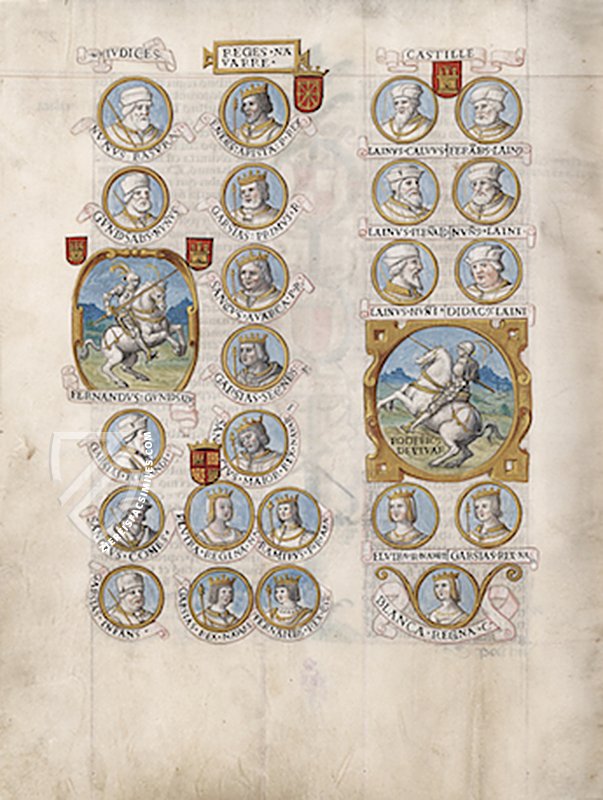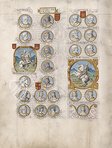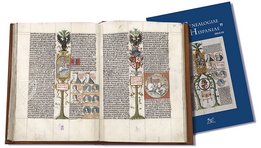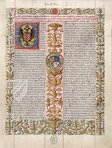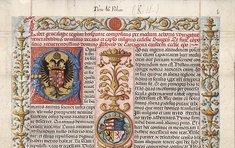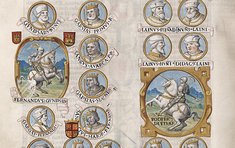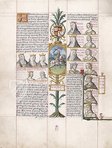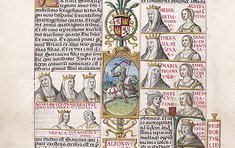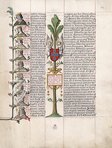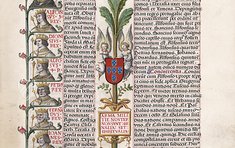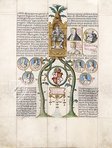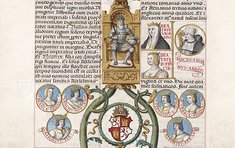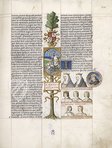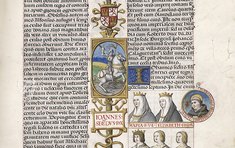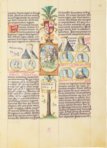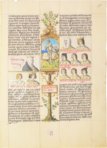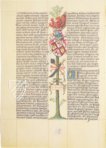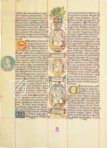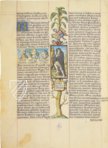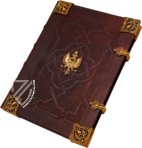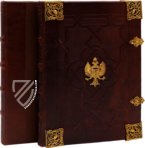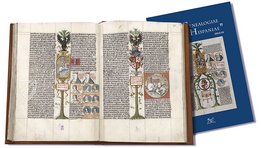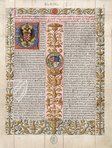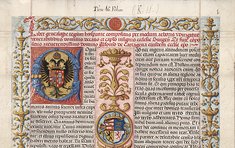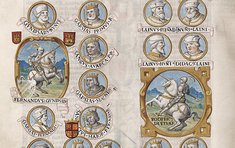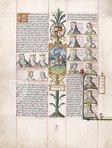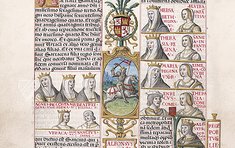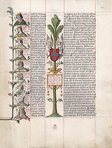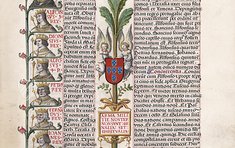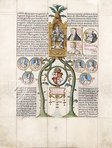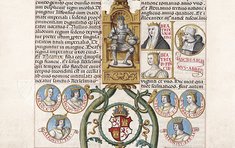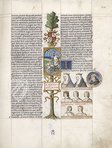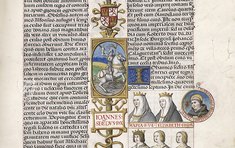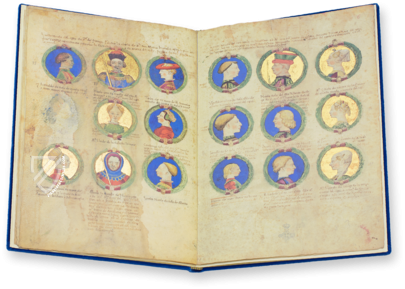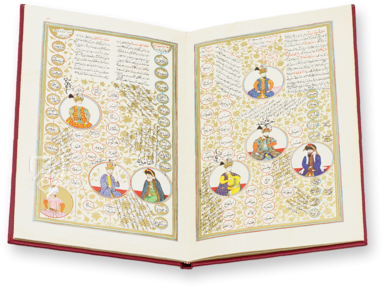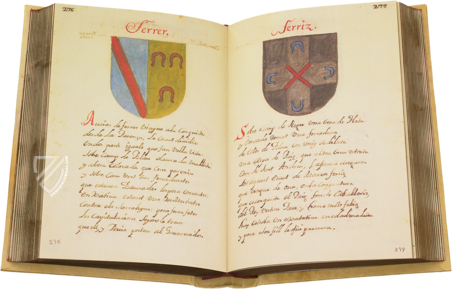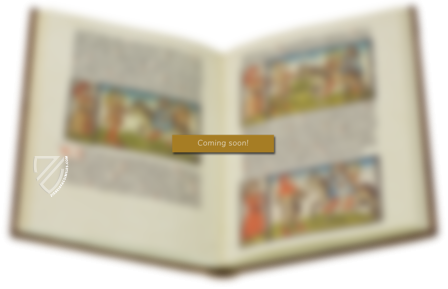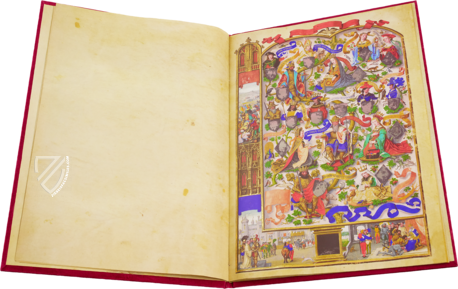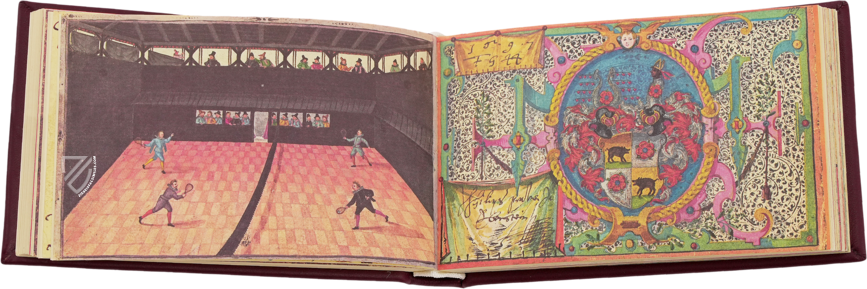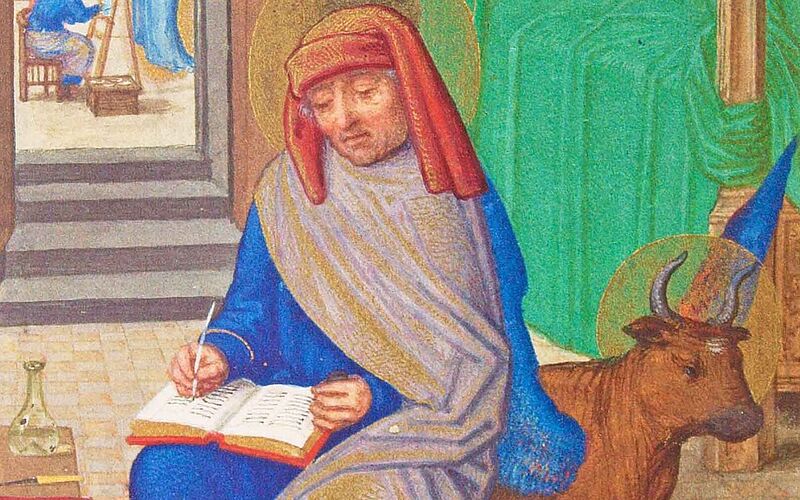Liber Genealogiae Regum Hispaniae
(over 10,000€)
The Liber Genealogiae Regum Hispaniae is a gorgeous and informative overview of the provenance of the Spanish kings. This manuscript is a specimen that was made between 1526 and 1539 for Isabella of Portugal. The text is based on the significant Anacephaleosis by Alfonso de Caratagena from the middle of the 15th century. A forward and 94 chapters covers the origins of the Spanish kings from Alaric, King of the Visigoths up to Henry IV, (1454–1471) King of Castile and León. The manuscript with its wonderful, exceedingly artistic décor offers a comprehensive inside look into Spanish history!
Liber Genealogiae Regum Hispaniae
The Liber Genealogiae Regum Hispaniae is a gorgeous and informative overview of the provenance of the Spanish kings. This manuscript is a specimen that was made between 1526 and 1539 for Isabella of Portugal. The text is based on the significant Anacephaleosis by Alfonso de Caratagena from the middle of the 15th century. A forward and 94 chapters covers the origins of the Spanish kings from Alaric, King of the Visigoths up to Henry IV, (1454–1471) King of Castile and León. The manuscript with its wonderful, exceedingly artistic décor offers a comprehensive inside look into Spanish history!
The Significant Work of a Grandiose Personality
Alfonso de Cartagena composed a history of Spain focusing on Castile in the Gothic era with the title Anacephaleosis ca. 1456. Alfonso de Cartagena (1384–1456) was a humanist, diplomat, historian, author, and was also active as a lawyer and natural philosopher. A converted Jew, he was employed in the Cathedral of Cartagena, was Deacon of Santiago and Segovia beginning in 1415, and Canon of Burgos beginning in 1421. Additionally, he was vested with the prestigious office of an apostolic nuncio. At the behest of King John II of Castile and León (1405–1454), Cartagena was involved as an ambassador and diplomat in political issues, the conflict between Castile, Aragon, and Grenada among them. At the same time, he composed translations of works by Cicero and Seneca. Alfonso de Cartagena was highly revered, even by popes for his diverse activities and his scholarship. Not least of all, he founded a school in Burgos where the most significant scholars of the era of the Catholic Monarchs studied.
The History of the Spanish Kingdom
For his Anacephaleosis, Cartagena drew upon the works of Flavius Josephus, Florus, and Jiménez de Rada. His history of Spain was published by Fernán Pérez de Guzmán and Juan de Villafuerte in 1463 under the title Geneologia de los Reyes de Espana. This consisted of a forward and 94 chapters and covered the origins of the Spanish kings from Alaric, King of the Visigoths, up to Henry IV (1454–1471) King of Castile and León and his son John II. Family trees show the various connections, e.g. to the royal houses of Navarra, Aragon, and Portugal.
The Family History of an Empress
The manuscript made for Empress Isabella of Portugal, Queen of Castile and Aragon and wife of Holy Roman Emperor Charles V enchants with its richly detailed pictorial décor. In this way the chronicle of the Castilian kings is made manageable and easily understood. On 110 pages, the manuscript measuring 35.5 x 25 cm contains 88 miniature pages altogether. The text, organized into two columns, is illustrated in an exceedingly rich manner, with miniatures on nearly every page. Genealogies in the form of family trees visualize the history of the Spanish kingdom for the reader with portraits of all persons involved. Lavish bordures, portrait medallions, countless coats of arms, emblems, and golden initials adorn the manuscript in the most superb Renaissance style. The escutcheon of the original owner, Queen Isabella of Portugal, is prominently displayed above a two-headed eagle with the imperial throne. Numerous historical personalities are presented in gorgeous portraits – sometimes the entire figure, sometimes only a head. This is simultaneously an informative history book and a magnificent 16th century work of art!
Codicology
- Alternative Titles
- Liber Genealogiae Regum Hispaniae de Alfonso de Cartagena
Book of the Genealogy of the Kings of Spain
Anacephaleosis
Libro de la Genealogia de los Reyes de Espana
Buch der Abstammung der spanischen Könige - Size / Format
- 110 pages / 33.5 × 25.0 cm
- Origin
- Spain
- Date
- Mid 15th century
- Epochs
- Style
- Language
- Illustrations
- 88 pages with illuminations
- Artist / School
- Alfonso de Cartagena (1384–1456) (author)
- Previous Owners
- Queen Isabella of Portugal (1503–39)
#1 Libro de la Genealogia de los Reyes de Espana (Paper edition)
Language: Spanish
(over 10,000€)
#2 Libro de la Genealogia de los Reyes de Espana (Parchment Facsimile)
Language: Spanish
(3,000€ - 7,000€)
- Treatises / Secular Books
- Apocalypses / Beatus
- Astronomy / Astrology
- Bestiaries
- Bibles / Gospels
- Chronicles / History / Law
- Geography / Maps
- Saints' Lives
- Islam / Oriental
- Judaism / Hebrew
- Single Leaf Collections
- Leonardo da Vinci
- Literature / Poetry
- Liturgical Manuscripts
- Medicine / Botany / Alchemy
- Music
- Mythology / Prophecies
- Psalters
- Other Religious Books
- Games / Hunting
- Private Devotion Books
- Other Genres
- Afghanistan
- Armenia
- Austria
- Belgium
- Belize
- Bosnia and Herzegovina
- China
- Colombia
- Costa Rica
- Croatia
- Cyprus
- Czech Republic
- Denmark
- Egypt
- El Salvador
- Ethiopia
- France
- Germany
- Greece
- Guatemala
- Honduras
- Hungary
- India
- Iran
- Iraq
- Israel
- Italy
- Japan
- Jordan
- Kazakhstan
- Kyrgyzstan
- Lebanon
- Liechtenstein
- Luxembourg
- Mexico
- Morocco
- Netherlands
- Palestine
- Panama
- Peru
- Poland
- Portugal
- Romania
- Russia
- Serbia
- Spain
- Sri Lanka
- Sweden
- Switzerland
- Syria
- Tajikistan
- Turkey
- Turkmenistan
- Ukraine
- United Kingdom
- United States
- Uzbekistan
- Vatican City
- A. Oosthoek, van Holkema & Warendorf
- Aboca Museum
- Ajuntament de Valencia
- Akademie Verlag
- Akademische Druck- u. Verlagsanstalt (ADEVA)
- Aldo Ausilio Editore - Bottega d’Erasmo
- Alecto Historical Editions
- Alkuin Verlag
- Almqvist & Wiksell
- Amilcare Pizzi
- Andreas & Andreas Verlagsbuchhandlung
- Archa 90
- Archiv Verlag
- Archivi Edizioni
- Arnold Verlag
- ARS
- Ars Magna
- ArtCodex
- AyN Ediciones
- Azimuth Editions
- Badenia Verlag
- Bärenreiter-Verlag
- Belser Verlag
- Belser Verlag / WK Wertkontor
- Benziger Verlag
- Bernardinum Wydawnictwo
- BiblioGemma
- Biblioteca Apostolica Vaticana (Vaticanstadt, Vaticanstadt)
- Bibliotheca Palatina Faksimile Verlag
- Bibliotheca Rara
- Boydell & Brewer
- Bramante Edizioni
- Bredius Genootschap
- Brepols Publishers
- British Library
- C. Weckesser
- Caixa Catalunya
- Canesi
- CAPSA, Ars Scriptoria
- Caratzas Brothers, Publishers
- Carus Verlag
- Casamassima Libri
- Centrum Cartographie Verlag GmbH
- Chavane Verlag
- Christian Brandstätter Verlag
- Circulo Cientifico
- Club Bibliófilo Versol
- Club du Livre
- CM Editores
- Collegium Graphicum
- Collezione Apocrifa Da Vinci
- Comissão Nacional para as Comemorações dos Descobrimentos Portugueses
- Coron Verlag
- Corvina
- CTHS
- D. S. Brewer
- Damon
- De Agostini/UTET
- De Nederlandsche Boekhandel
- De Schutter
- Deuschle & Stemmle
- Deutscher Verlag für Kunstwissenschaft
- DIAMM
- Droz
- E. Schreiber Graphische Kunstanstalten
- Ediciones Boreal
- Ediciones Grial
- Ediclube
- Edições Inapa
- Edilan
- Editalia
- Edition Deuschle
- Edition Georg Popp
- Edition Leipzig
- Edition Libri Illustri
- Editiones Reales Sitios S. L.
- Éditions de l'Oiseau Lyre
- Editions Medicina Rara
- Editorial Casariego
- Editorial Mintzoa
- Editrice Antenore
- Editrice Velar
- Edizioni Edison
- Egeria, S.L.
- Eikon Editores
- Electa
- Emery Walker Limited
- Enciclopèdia Catalana
- Eos-Verlag
- Ephesus Publishing
- Ernst Battenberg
- Eugrammia Press
- Extraordinary Editions
- Fackelverlag
- Facsimila Art & Edition
- Facsimile Editions Ltd.
- Facsimilia Art & Edition Ebert KG
- Faksimile Verlag
- Feuermann Verlag
- Folger Shakespeare Library
- Franco Cosimo Panini Editore
- Friedrich Wittig Verlag
- Fundación Hullera Vasco-Leonesa
- G. Braziller
- Gabriele Mazzotta Editore
- Gebr. Mann Verlag
- Gesellschaft für graphische Industrie
- Getty Research Institute
- Giovanni Domenico de Rossi
- Giunti Editore
- Graffiti
- Grafica European Center of Fine Arts
- Guido Pressler
- Guillermo Blazquez
- Gustav Kiepenheuer
- H. N. Abrams
- Harrassowitz
- Harvard University Press
- Helikon
- Hendrickson Publishers
- Henning Oppermann
- Herder Verlag
- Hes & De Graaf Publishers
- Hoepli
- Holbein-Verlag
- Houghton Library
- Hugo Schmidt Verlag
- Idion Verlag
- Il Bulino, edizioni d'arte
- ILte
- Imago
- Insel Verlag
- Insel-Verlag Anton Kippenberger
- Instituto de Estudios Altoaragoneses
- Instituto Nacional de Antropología e Historia
- Introligatornia Budnik Jerzy
- Istituto dell'Enciclopedia Italiana - Treccani
- Istituto Ellenico di Studi Bizantini e Postbizantini
- Istituto Geografico De Agostini
- Istituto Poligrafico e Zecca dello Stato
- Italarte Art Establishments
- Jan Thorbecke Verlag
- Johnson Reprint Corporation
- Josef Stocker
- Josef Stocker-Schmid
- Jugoslavija
- Karl W. Hiersemann
- Kasper Straube
- Kaydeda Ediciones
- Kindler Verlag / Coron Verlag
- Kodansha International Ltd.
- Konrad Kölbl Verlag
- Kurt Wolff Verlag
- La Liberia dello Stato
- La Linea Editrice
- La Meta Editore
- Lambert Schneider
- Landeskreditbank Baden-Württemberg
- Leo S. Olschki
- Les Incunables
- Liber Artis
- Library of Congress
- Libreria Musicale Italiana
- Lichtdruck
- Lito Immagine Editore
- Lumen Artis
- Lund Humphries
- M. Moleiro Editor
- Maison des Sciences de l'homme et de la société de Poitiers
- Manuscriptum
- Martinus Nijhoff
- Maruzen-Yushodo Co. Ltd.
- MASA
- Massada Publishers
- McGraw-Hill
- Metropolitan Museum of Art
- Militos
- Millennium Liber
- Müller & Schindler
- Nahar - Stavit
- Nahar and Steimatzky
- National Library of Wales
- Neri Pozza
- Nova Charta
- Oceanum Verlag
- Odeon
- Orbis Mediaevalis
- Orbis Pictus
- Österreichische Staatsdruckerei
- Oxford University Press
- Pageant Books
- Parzellers Buchverlag
- Patrimonio Ediciones
- Pattloch Verlag
- PIAF
- Pieper Verlag
- Plon-Nourrit et cie
- Poligrafiche Bolis
- Presses Universitaires de Strasbourg
- Prestel Verlag
- Princeton University Press
- Prisma Verlag
- Priuli & Verlucca, editori
- Pro Sport Verlag
- Propyläen Verlag
- Pytheas Books
- Quaternio Verlag Luzern
- Reales Sitios
- Recht-Verlag
- Reichert Verlag
- Reichsdruckerei
- Reprint Verlag
- Riehn & Reusch
- Roberto Vattori Editore
- Rosenkilde and Bagger
- Roxburghe Club
- Salerno Editrice
- Saltellus Press
- Sandoz
- Sarajevo Svjetlost
- Schöck ArtPrint Kft.
- Schulsinger Brothers
- Scolar Press
- Scrinium
- Scripta Maneant
- Scriptorium
- Shazar
- Siloé, arte y bibliofilia
- SISMEL - Edizioni del Galluzzo
- Sociedad Mexicana de Antropología
- Société des Bibliophiles & Iconophiles de Belgique
- Soncin Publishing
- Sorli Ediciones
- Stainer and Bell
- Studer
- Styria Verlag
- Sumptibus Pragopress
- Szegedi Tudomànyegyetem
- Taberna Libraria
- Tarshish Books
- Taschen
- Tempus Libri
- Testimonio Compañía Editorial
- Thames and Hudson
- The Clear Vue Publishing Partnership Limited
- The Facsimile Codex
- The Folio Society
- The Marquess of Normanby
- The Richard III and Yorkist History Trust
- Tip.Le.Co
- TouchArt
- TREC Publishing House
- TRI Publishing Co.
- Trident Editore
- Tuliba Collection
- Typis Regiae Officinae Polygraphicae
- Union Verlag Berlin
- Universidad de Granada
- University of California Press
- University of Chicago Press
- Urs Graf
- Vallecchi
- Van Wijnen
- VCH, Acta Humaniora
- VDI Verlag
- VEB Deutscher Verlag für Musik
- Verlag Anton Pustet / Andreas Verlag
- Verlag Bibliophile Drucke Josef Stocker
- Verlag der Münchner Drucke
- Verlag für Regionalgeschichte
- Verlag Styria
- Vicent Garcia Editores
- W. Turnowski Ltd.
- W. Turnowsky
- Waanders Printers
- Wiener Mechitharisten-Congregation (Wien, Österreich)
- Wissenschaftliche Buchgesellschaft
- Wissenschaftliche Verlagsgesellschaft
- Wydawnictwo Dolnoslaskie
- Xuntanza Editorial
- Zakład Narodowy
- Zollikofer AG

